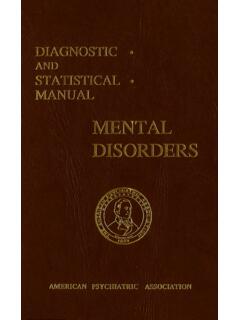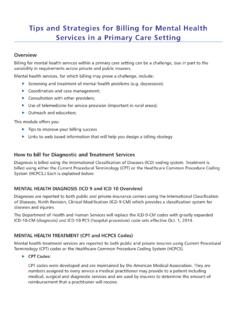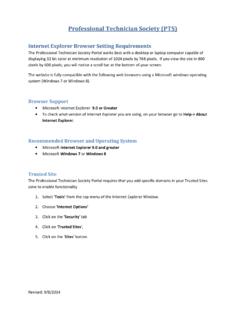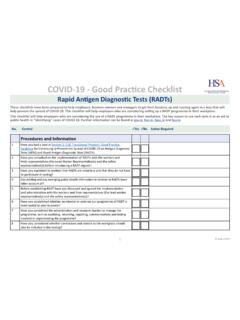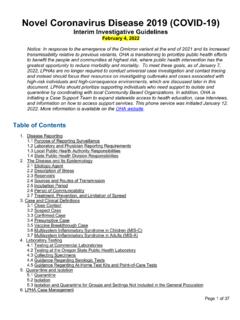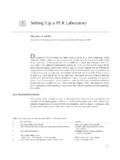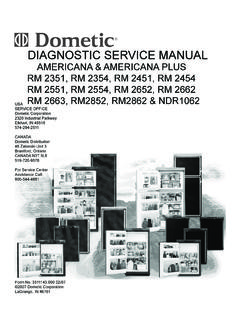Transcription of Guidance for Clinicians on the Use of Rapid Influenza ...
1 Guidance for Clinicians on the Use of Rapid Influenza Diagnostic Tests Background Rapid Influenza diagnostic tests (RIDTs) are immunoassays that can identify the presence of Influenza A and B viral nucleoprotein antigens in respiratory specimens, and display the result in a qualitative way (positive vs. negative) (1). In the United States, a number of RIDTs are commercially available. (See Table 1: Influenza Virus Testing Methods and Table 2: Characteristics of Rapid Influenza Diagnostic Tests .) The reference standards for laboratory confirmation of Influenza virus infection are reverse transcription-polymerase chain reaction (RT-PCR) or viral culture. RIDTs can yield results in a clinically relevant time frame, , approximately 15 minutes or less. However, RIDTs have limited sensitivity to detect Influenza virus infection and negative test results should be interpreted with caution given the potential for false negative results.
2 1 RIDTs do not include Rapid molecular assays. Rapid molecular assays are a new type of Influenza diagnostic test that use isothermal nucleic acid amplification for viral detection. At present, only one Rapid molecular assay is FDA-approved for use in the United States. Advantages and Disadvantages of RIDTs Advantages Produce quick result in 15 minutes or less, simple to perform Some RIDTs are approved for office/bedside use Disadvantages Sub-optimal test sensitivity, false negative results are common, especially when Influenza activity is high Although specificity is high, false positive results can also occur, especially during times when Influenza activity is low Some RIDTs distinguish between Influenza A or B virus infection while others do not. RIDTs that provide results on type of Influenza virus ( Influenza A or B virus), do not provide information on Influenza A virus subtype ( A/H1N1 versus A/H3N2) or specific strain information ( degree of similarity to vaccine strains) Use of RIDTs in Clinical Decision-making RIDTs may be used to help with diagnostic and treatment decisions for patients in clinical settings, such as whether to prescribe antiviral medications.
3 However, due to the limited sensitivities and predictive values of RIDTs, negative results of RIDTs do not exclude Influenza virus infection in patients with signs and symptoms suggestive of Influenza . Therefore, antiviral treatment should not be withheld from patients with suspected Influenza , even if they test negative. More information about Antiviral Drugs and recommendations on their use. Testing is not needed for all patients with signs and symptoms of Influenza to make antiviral treatment decisions (See Figures 1-4). Once Influenza activity has been documented in the community or geographic area, a clinical diagnosis of Influenza can be made for outpatients with signs and symptoms consistent with suspected Influenza , especially during periods of peak Influenza activity in the community. Use of RIDTs for Public Health Purposes to Detect Influenza Outbreaks RIDTs can be useful to identify Influenza virus infection as a cause of respiratory outbreaks in any setting, but especially in institutions ( , nursing homes, chronic care facilities, and hospitals), cruise ships, summer camps, schools, etc.
4 Positive RIDT results from one or more ill persons with suspected Influenza can support decisions to promptly implement prevention and control measures for Influenza outbreaks. However, negative RIDT results do not exclude Influenza virus infection as a cause of a respiratory outbreak because of the limited sensitivity of these tests. Testing respiratory specimens from several persons with suspected Influenza will increase the likelihood of detecting Influenza virus infection if Influenza virus is the cause of the outbreak. Public health authorities should be notified of any suspected institutional outbreak and respiratory specimens should be collected from ill persons (whether positive or negative by RIDT) and sent to a public health laboratory for more accurate Influenza testing. Factors Influencing Results of RIDTs Many factors can influence the accuracy of RIDTs, including: Clinical signs and symptoms consistent with Influenza o Having clinical signs and symptoms consistent with Influenza increases the pre-test probability of Influenza virus infection, which increases the reliability of a positive RIDT result.
5 Prevalence of Influenza activity in the population tested o Influenza activity varies seasonally, which directly affects the predictive values of RIDTs (See algorithms below [Figures 3 and 4], and Prevention Strategies for Seasonal Influenza in Heath Care Settings.) Time from illness onset to collection of respiratory specimens for testing o Testing specimens collected within 48-72 hours of illness onset (when Influenza viral shedding is highest) is more likely to yield positive RIDT results. Type of respiratory specimen tested o RIDTs have different specifications for acceptable specimens ( nasopharyngeal, nasal or throat swab/aspirate). The package insert for the RIDT test used should be reviewed to ensure that an appropriate specimen is collected, and test procedures are followed. Some tests may require specimen collection using a special swab (some RIDTs must be used with a swab supplied with the test kit; some swab material can interfere with RIDT results).
6 O RIDTs must also ensure that the appropriate viral transport media or other media is used, consistent with test specifications, if testing is done at a different location from where the specimen is collected from the patient. o Collection of good quality respiratory specimens ( nasopharyngeal or nasal swab/aspirate/wash or combined nasal/throat swab specimens) also will increase accuracy of RIDT results. o Some RIDTs require that the entire collected specimen be used in the test. Consider whether a second specimen should be collected for confirmatory testing using viral culture and/or RT-PCR. Accuracy of the test compared to a reference test ( gold standard = RT-PCR or viral culture) o Sensitivity of the RIDT Proportion of positive RIDT results of all positive gold standard test results (RT-PCR or viral culture) Fixed characteristic of a test; generally low to moderate (10-70%) for RIDTs An RIDT with low sensitivity will produce negative results in patients with Influenza (false negatives) Specificity of the RIDT o Proportion of negative RIDT results of all negative gold standard test results (RT-PCR or viral culture) o Fixed characteristic of a test; generally very high for RIDTs (90-95%) An RIDT with very high specificity will not produce many positive results in patients who do not have Influenza (few false positives) Interpretation of Rapid Influenza Diagnostic Test Results The reliability of RIDTs depends largely on the conditions under which they are used.
7 Understanding some basic considerations can minimize being misled by false-positive or false-negative results. Sensitivities of RIDTs are generally 40-70%, but a range of 10-80% has been reported compared to viral culture or RT-PCR. Specificities of RIDTs are approximately 90-95% (range 85-100%). Thus false negative results occur more commonly than false positive results. o Negative results of RIDTs do not exclude Influenza virus infection and Influenza should still be considered in a patient if clinical suspicion is high based upon history, signs, symptoms and clinical examination. False-positive (and true-negative) results are more likely to occur when disease prevalence in the community is low, which is generally at the beginning and end of the Influenza season and during the summer. o The negative predictive value of an RIDT (the proportion of patients with negative results who do not have Influenza ) is highest when Influenza activity is low.
8 O The positive predictive value of an RIDT (the proportion of patients with positive results who have Influenza ) is lowest when Influenza activity is low. False-negative (and true-positive) results are more likely to occur when disease prevalence is high in the community. o The positive predictive value of an RIDT (the proportion of patients with positive results who have Influenza ) is highest when Influenza activity is high o The negative predictive value of an RIDT (the proportion of patients with negative results who do not have Influenza ) is lowest when Influenza activity is high Minimize False Results Collect specimens as early in the illness as possible (ideally less than 4 days from illness onset). Follow manufacturer's instructions, including acceptable specimens, and handling. Follow-up negative results with confirmatory tests (RT-PCR or viral culture) if a laboratory-confirmed Influenza diagnosis is desired.
9 Clinicians should contact their local or state health department for information about current Influenza activity. For more information about Influenza activity in the , during the Influenza season, visit the Weekly Influenza Surveillance Report (FluView) . When to Consider Further Influenza Testing Consider sending respiratory specimens for Influenza testing by viral culture or RT-PCR to confirm results of an RIDT when: A patient tests negative by RIDT when community Influenza activity is high and laboratory confirmation of Influenza is desired. A patient tests positive by RIDT and the community prevalence of Influenza is low, and a false positive result is a consideration. A patient has had recent close exposure to pigs or poultry or other animals and novel Influenza A virus infection is possible ( Influenza viruses circulate widely among swine and birds, including poultry, and also can infect other animals such as horses and dogs) Hospitalized patients Influenza testing is recommended for hospitalized patients with suspected Influenza .
10 However, empiric antiviral treatment should be initiated as soon as possible without the need to wait for any Influenza testing results (see Antiviral Drugs, Information for Health Care Professionals). Antiviral treatment should not be stopped based on negative RIDT results given the limited sensitivities of RIDTs. Infection control measures should be implemented immediately upon admission for any hospitalized patient with suspected Influenza even if RIDT results are negative (see Prevention Strategies for Seasonal Influenza in Heath Care Settings). Respiratory specimens can be tested for Influenza by immunofluorescence, RT-PCR or viral culture. Serology should not be performed for clinical management. Clinicians should understand that negative results of Influenza testing do not exclude Influenza virus infection, especially if the time from illness onset to collection of respiratory specimens is more than 5 to 7 days, or if upper respiratory specimens were tested and the patient has lower respiratory tract disease.











